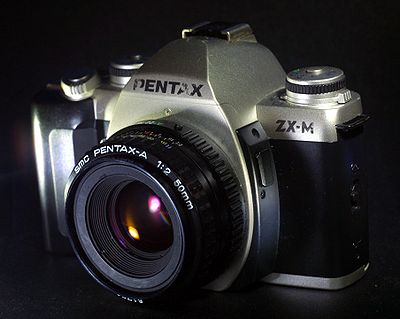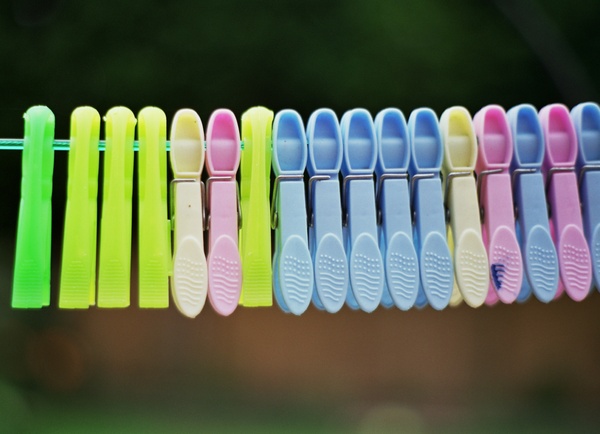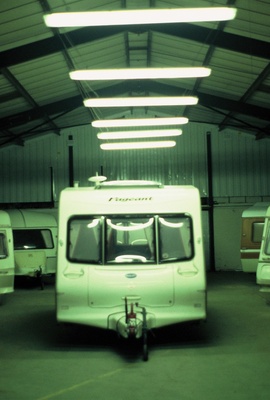
from Shutter, by Lewis Collard

This is the Pentax ZX-M, also known as the MZ-M, a manual focus 35mm SLR camera that was announced in 1997, and the spiritual successor to the legendary K1000. It's a "student" version of the autofocus Pentax ZX/MZ series cameras; Pentax ripped out the autofocus, added manual focus aids, and replaced the pentaprism of its more expensive AF stablemates with a pentamirror. It is is a marvelously light, very usable manual focus film camera that I take almost everywhere when I don't feel like hauling around digital bricks or my Canon A-1.

Pegs. Pentax ZX-M with Pentax 50mm
f/2 wide-open, Fuji Pro 160C print film.
All plastic. It's incredibly light. The body weighs 305 grams! That's about the same as the 2-frames-per-second go-faster stripes for my A-1, and you get a free camera thrown in, woot! Add an extra 20 grams or so for batteries and it's still insanely light. Stick a plastic lens on it and you're good to go!
(Yup, the "plastic" thing includes the lens mount, so you'd better not go attach some old, monstrous lens like the 1980s 70-220 f/3.5 that I temporarily borrowed. Who cares?)
Forget everything else I'll write here and get one on that count alone.That is the main reason to own this camera. Alright, I'm weird. I don't mind carrying around over two pounds of obsolete digital SLR or motor-driven film muncher, but most people do. Yup, this is the sort of camera that professionals might look down on as a consumer toy (and people on the Internet pretending to be professionals certainly would), but who cares? If you're not an gear-abusing idiot like me, you'd have to try pretty hard to break a plastic-bodied camera. And the fact that this camera is light enough that you won't mind carrying it with you, means you'll get infinitely better photographs with it than the three pound "professional" anvil that you left at home.
Like tripods? I don't, but an added bonus of its non-existent weight is that you can use the cheapest £10 plastic tripod with it.
Metal (probably the only metal part on the whole camera, heh heh), vertical-travel focal plane shutter. Your fastest speed is 1/2000 (more than enough; as I've said before, if you're shooting fast film wide-open in daylight these days, you're a very strange person). It goes from there in full stops to 2 seconds on the shutter dial, but the camera can time exposures of 30 seconds in program automatic and aperture priority modes. It's very quiet; most of the noise and vibration the camera makes is from the "zip" sound of the motor winding on, not the shutter.
Flash sync is 1/100. This is pretty "meh", but I don't use flash much anyway.

Wheel. Pentax ZX-M in program auto with
Pentax 50mm f/2, shooting Fuji Sensia 400, straight off the scanner
at Fuji's lab.
Proprietary Pentax; you can't use standard threaded cable releases. Bad Pentax! Go sit in the corner!
Through-the-lens, metering range from LV 1 to LV 15. If you're shooting a lens with electronic contacts (KAF, KAF2 and KA), you get a two-segment averaging meter, which from one account I read, is crappy. Without those contacts (like with the 50mm f/2 pictured), you get center-weighted averaging, which is at least predictable if you know what you are doing. Rumours on the Internets say that the meter is inaccurate in extreme lighting conditions, so watch it if you're shooting slide film. I've not noticed this myself, though I'm stuck in centre-weighted mode and sorta know what I'm doing (or so I pretend on the Internet). I've found that the meter is dead-on accurate, even on slide film; I've only messed up an exposure when I thought I knew better than the meter and set exposure compensation.
If you're shooting negative film, don't sweat it. Just shoot it a half stop over all the time like I do.

cnv00031.jpg, because I can't think
of a good name for it. Pentax ZX-M in program auto with Pentax 50mm f/2,
shooting Fuji Sensia 400 slide film, straight off the scanner
at Fuji's lab. Taken in the same place as
this one, but with less
effort, because it's film.
The big "ML" (memory lock) button on the rear right of the camera is your auto-exposure lock. Press once to lock the exposure for ten seconds, press again to unlock it. This is much, much smarter and intuitive than Canon EOS, which requires you to wait for the meter to time out to unlock it. It's much better than Nikon and Canon FD cameras, which require you to hold the button down for as long as you want the lock. Still, the damn thing beeps at you when you press it. Why oh why, Pentax? I wish there was some way to turn this beeping off, but there isn't. Not without taking the camera apart and replacing the speaker with a resistor or something, which I haven't done, yet.
You get exposure compensation, -3 to +3 -- in half stops, which may be suboptimal for slide film. You get an indication in the viewfinder when you set this, and the dial is very simple to use, so you can do it without looking away from the viewfinder, unlike my A-1. Hooray!
The Pentax gives you aperture-priority and shutter-priority AE, and fully automatic programmed AE, plus a metered manual mode if you want to party like it's 1965. No silly mode dials here. To get programmed AE, set both the aperture and shutter speed to "A". To operate either or both of these manually, turn them off "A". Straightforward enough. "Program" works great for me.

Flowers. Pentax ZX-M and Pentax 50mm f/2 in
program auto shooting Fuji Sensia 400 slide film, straight out the
scanner at Fuji's lab (I didn't even bother cropping the black bit at the
left, which was a scanning error, because I'm cool like that). Sensia's
reds = pure awesome.
The ZX-M takes two 3v CR2 cells. The camera won't function at all without them. Buy these from Fleabay or Amazon; camera shops rip you off horribly (I could have got twelve online for the price I paid for two!). Despite powering the winder and all the camera's electronics, Pentax rate these for 120 rolls of 24-exposure film at 20 degrees Celsius, or 30 rolls at -10. That's much colder than it ever gets in Norfolk, of course. Talking of which, here's some folks on a forum who have used this camera in temperatures below -30 degrees C. Cool. (Pun intended.)
If you like using AA batteries, the Pentax FG battery grip should fit it and give you enough power for 200 rolls of 24-exposure film. I've not tried this, though I suspect when the flimsy battery door breaks on this camera I might have to.
The MZ-M uses the Pentax K mount, and yes, you get a DOF preview button. It's a manual-focus camera, but it does take advantage of some features of chipped autofocus lenses.
Compatibility? Yup! ;) Props to Pentax here; this is compatible with almost every K-mount lens ever made. This is awesome. This gives you access to over three decades' worth of lenses, some of them quite superb (like the 50mm f/2 I took all these shots with). Better, if you decide to downgrade from a real camera to their digital SLRs, they'll work fine on them too.
Hey you! Yeah you over there with the F-mount, I'm looking at you! As much as Nikon fans talk up lens compatibility, Karen Nakamura points out that there are "enough "buts" and incompatibilities to fill a wall chart". Hey, here's that wall chart, heh heh. Go Pentax!
Alright, so enough trolling Nikon users. Mark Roberts hints (in the context of digital cameras) that you'll lose shutter-priority AE on lenses without an "A" position, which makes sense. Also, in aperture priority mode, you'll lose your aperture display in the viewfinder with anything that isn't a KAF (F) or KAF2 (FA) lens. Not really a compatibility issue; you're not losing features that these lenses would give you on any other camera.
This only applies to real Pentax lenses. Third-party ones (apart from being, for the most part, pretty crappy) may or may not bring their own incompatibilities. There's a horror story here (and an even funnier one here about what third party lenses can do. That was on an autofocus digital SLR, but his advice is very sound anyway: "if you have a Pentax body and are considering a non-Pentax lens, don't do it unless you know for certain that the lens will physically fit on that body."
You also get to use M42 lenses by an adapter for which Pentax made an adapter (and a million Chinese machine shops still do), if you're that way inclined. I'm not; the 50mm f/2 is the only lens I'll ever need, and I'd speculate that good M42 glass, such as the superb Super-Takumar lenses, is more expensive than good K-mount glass, simply because there's nobody buying K-mount lenses and shoving them on their Canon digital SLRs. Want to know the perfect match for this camera? The Industar 50mm f/3.5 M42 pancake. It weighs a whole 65 grams and it's thin enough that you'll be able to get the camera, lens and all, into your pocket.
There's even some adapters for Pentax 645 lenses out there if you're really weird. This must look incredibly silly and I don't know why anyone would do this (especially given that you could go get some superb K-mount lenses for the price of the adapter), but that's photographers for you.
I got a quite incredible (and very cheap!) Pentax 50mm f/2 and 80-200mm f/4.7-5.6 with mine; it's often sold as a kit with a slow 35-85mm zoom. Get the 50mm f/2 and you won't need any other lens, even though the aperture ring of the 50mm f/2 feels pretty nasty to me. (I'm spoiled because my main camera for years was a Voigtlander Vito B; every aperture ring is nasty in comparison.)

Butterfly. Pentax ZX-M with Pentax 50mm f/2 in
program auto shooting Fuji Sensia 400 slide film, straight off the
scanner at Fuji's lab. Boring snapshot, but check out the deep, rich
reds!
It'll read DX-coded films from ISO 25 to 5000. This always works, though I'm paranoid and always swing the exposure compensation dial around to "ISO" to make sure it has detected it properly (it has every time so far). Like weird film? You can use films from ISO 6 (!) to 6400 if you set the ISO manually. Bonus feature: The LCD says "E" if the film is not loaded properly. You need this on a camera without a manual rewind crank, because there's no rewind crank spinning as the camera winds on to tell you that the film is loaded properly.
No built in flash, sorry. Even with Pentax's dedicated flash, you don't get TTL autoflash at all. The manual tries to scare you into only using Pentax flash units, but they would say that, wouldn't they? I haven't set fire to the camera using a big old Nissin 360TW, so make of that what you will.
Motorised, about two shots per second, and you have the option of continuous shooting. Rewind is automatic and motorised, too, as is film advance to the first frame when you load the film.

Caravan. Pentax ZX-M with Pentax 50mm f/2
in program auto (which chose f/2 at 1/30 as I recall) shooting Fuji
Sensia slide film. A bit blurry, if you look too hard; I was hand-holding
it at 1/30 with my cold shaky hands, and the lighting is crappy flourescent.
I kinda liked it anyway, so I'm forcing it upon you. Edited only to
rotate and crop.
SLR pentamirror (not a pentaprism -- another reason this camera is very light). 0.77x magnification and about 90% finder coverage, so you get more on film than you see in your finder. The finder is far brighter than you'd expect from a small pentamirror, and manual focusing (even on slow lenses like the f/4.7-5.6) is a breeze with the split-image and microprism ring.
You get shutter speed and aperture displays in the top left (though in aperture priority and metered manual, you'll only see the aperture display if you've got a lens with electronic contacts, as mentioned earlier), and an LCD exposure bar graph right underneath. In the automatic modes, the LCD bar graph on the left shows you how much exposure compensation you are using, and turns off altogether if you don't have any set (chew on that, Canon!). In fully manual mode, this works as your over- and under-exposure meter. It's as well-designed as anything I've ever seen, even if the LCD display is a little dim for bright daylight.
Stick it in program auto ("A" on both the aperture ring and shutter dial) and just shoot. Everything works just as it should do, and everything is where it should be. Actually, the first thing I noticed was that the power switch is in just the right place: right in front of the grip, so if you forget to turn it on (I did) you can turn it on easily with one finger. It's more awkward to turn off, but I doubt you'd ever have to do this in a hurry. Actually, I find the button to be a little slippery, so I'm probably going to stick a bit of rubber on it to make it even easier to use one-fingered.
Whine whine whine. Ignore my nit-picking; I could find things I dislike in just about any camera that isn't a Trip 35. This camera is a joy to use. Yes, it does its R2-D2 impression when you use the AE lock. Yup, it feels kinda plasticky, because it is. That's the price you pay for a camera which weighs so little that you'll forget it's there.

Yellow. Pentax ZX-M with 50mm f/2
in program auto, Fuji Sensia 400 slide film, +1 stop exposure compensation
(I thought I knew better than the meter, but this was too much; I edited
this a tiny bit to pull the levels down a little).
There cost next to nothing these days -- another good reason to get one. Once again, an enormous thanks to Teresa (see me use font sizes to comic effect!!) who bought this camera and lens and never really got the hang of it, and rather than letting them gather dust, sent it for the price of shipping from Washington to someone who would use it. Don't bother with the kits from Amazon or anywhere else; keep an eye out on Fleabay and in charity shops, because I dare say she's not alone in wanting to get rid of one of these.